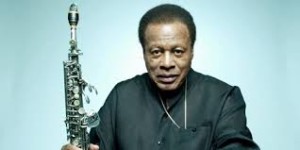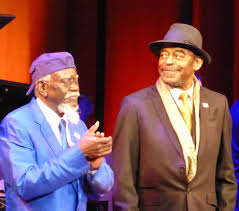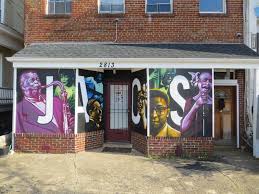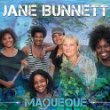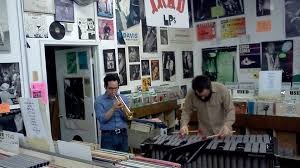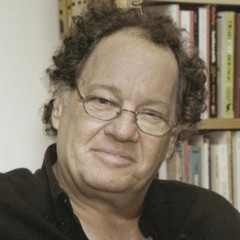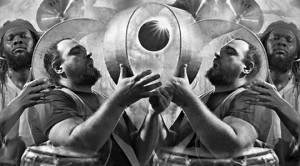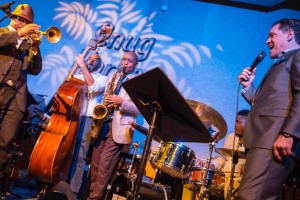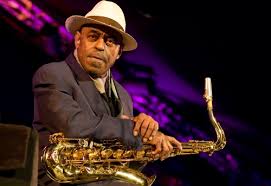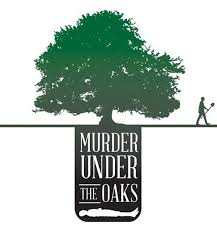Though the Guggenheim Foundation has in recent practice conferred several of its prestigious annual fellowships on musicians of jazz or beyond, only Wayne Shorter, the great 83 year old saxophonist-composer — an NEA Jazz Master, co-founder of Weather Report, veteran of Miles Davis’ great 1960’s quintet and before that Art Blakey’s Jazz Messengers — represents music creativity from that legacy […]
At the NEA’s Jazz Masters Ball
The Kennedy Center was filled Monday night with VIPs, devotees and artists across disciplines for the 34th annual celebration of Jazz Masters by the National Endowment of the Arts. Here’s my coverage for DownBeat magazine on the tribute to the 2016 honorees: Fierce and soulful  saxophonists Archie Shepp and Pharoah Sanders, cool yet lyrically expressive vibist Gary […]
Local DC jazz apart from NEA Jazz Masters events
In Washington DC for events surrounding the investiture of vibist Gary Burton, saxophonists Pharoah Sanders and Archie Shepp and Jazz Foundation of America‘s executive director Wendy Oxenhorn as National Endowment of the Arts’  Jazz Masters, I visited a new grassroots venue that shows where the deep heart of jazz support lies. The Jazz and Cultural Society is an 11-month old […]
Historic days for US and Cuba, accompanied by jazz
Congratulations to the U.S. and Cuba for advancing our long overdue reset. It’s about time. Jazz at its best has linked our nations for decades, through the tangled history of corrupt dictatorship and revolution, missile crisis, failed invasion, bad relations and trade embargo — and in this recent historic moment, Afro-Cuban-American music is exploding with exciting new recordings. A hint of accords and collaborations […]
Ornette Day, bits of wisdom with video clips
Ornette Coleman’s birthday is today, and his son Denardo has invited everyone to a walk with him from noon to three in Woodlawn Cemetery in the Bronx, where his father, the prophet of Harmolodics, is interred near Duke Ellington, Miles Davis, Max Roach, Celia Cruz — a very good neighborhood. In Ornette’s honor here are excerpts of […]
Mavis Staples’ HBO doc hits relevant Civil Rights notes
“I’m not as frisky as I used to be but I feel like I am,” Mavis Staples speaks the truth with a grin and a twinkle in Mavis!, an endearingly upbeat bio doc premiering on HBO tonight (Monday, February 29). Appearing early in the month for a sneak preview at Chicago’s Du Sable Museum, the 76-year-old Chicago […]
Chicagoans’ albums reviewed, author’s edition
My reviews of recordings  by Chicago pianists Larry Novak, Laurence Hobgood and Robert Irving III, percussionist Art “Turk” Burton, and saxophonists Caroline Davis and Roy McGrath appeared in DownBeat‘s January issue, but the print edition limited their length. DB’s rating system ranges from one to five stars (*s), poor to masterpiece. Here’s my text as […]
Why’s nobody mourning Paul Kantner? Jefferson Airplane flies forever
Jefferson Airplane founding member Paul Kantner’s death at age 74 on Jan. 28 has been met by a mainstream culture shrug compared to the celebratory attention paid rock stars dead in the past month including David Bowie, the Eagles’ Glenn Frey and Scott Weiland of Stone Temple Pilots. Why? In one hour since posting this, […]
Immodest me, in Steve Cerra’s Jazz Profiles
Thanks to Steve Cerra of Jazz Profiles for asking me a few questions by email, and letting me go on and on. Of course my answers are far from comprehensive, opinions are only my own, and I cited only a few of dozens of my favorites of record albums (no non-jazz music noted, for instance) […]
Solstice beyond jazz, unruly mashup to meditative rhythm
Saxophonist Mars Williams and band ecstatically wed holiday songs and Albert Ayler anthems at the Hungry Brain in Chicago past 12 pm December 20  — the deepest, darkest, longest night of the year — then at 6 am December 21 percussionists Hamid Drake and Michael Zerang performed a flowing, meditative duet to get the sun up, for a crowd that felt […]
Branford Marsalis and Kurt Elling in New Orleans, ready for recording
Saxophonist Branford Marsalis’s quartet and singer Kurt Elling prepared for their upcoming recording in a rare four-night stand at Snug Harbor in New Orleans last week, and photo-journalist extraordinaire Marc PoKempner went each night, enthralled. “It was sort of an open rehearsal for the recording, so the set list was the same every night,” PoKempner reported […]
NEA doubles down on beyond-jazz with 2016 Jazz Masters
The National Endowment of the Arts has doubled down on celebrating jazz beyond “jazz” — music that has exploded historic parameters or preconceptions of  “jazz” conventions — by naming as 2016 Jazz Masters the saxophonists Pharoah Sanders and Archie Shepp — both protégés of the late, great John Coltrane — and Gary Burton, an innovator of technique and content who’s embraced pop, […]
Bouchercon 2015 Raleigh (writing not jazz)
A crime writing conference attracting 1400-some authors and readers, flush for four days with panels and book talk — that was the 45th annual Bouchercon “world mystery convention,” held in Raleigh NC Oct. 8 through 11 at downtown Sheraton and Marriott hotels. Taking a break from music immersion, I attended as a fan with a […]

